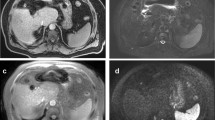Abstract
Diffuse liver diseases have a definitive radiological importance due to the ability of MR imaging to demonstrate abnormalities before the patient is symptomatic or the liver damage is advanced. Biopsy procedures are invasive, may lead to complications and have a sample bias. Imaging biomarkers target to fat, water, and iron tissue concentrations may be considered as hepatic virtual biopsies. There is a need to identify a rapid and practicable method to accurately quantify liver steatosis, differentiate steatohepatitis from simple steatosis, grade the necroinflammatory activity, calculate the liver iron burden and monitor overload progression. MR is used in the evaluation of diffuse liver disorders with accurate approaches such as the use of chemical shift, Dixon vector analysis, turbo spin echo fat suppression, and T2* gradient echo techniques. These methods are influenced by some factors like proportional ambiguity, T1 and T2* effects on signal decay, adding a significant bias in the combined fat–water–iron quantification. A GRE multi-echo chemical shift sequence was configured to independently calculate fat, water, and iron parametric liver images. It is now necessary to conduct a pilot project in order to validate this method in a group of subjects without and with different grades of fat, water, and iron liver changes.




Similar content being viewed by others
References
Martí-Bonmatí L, Talens A, del Olmo J, et al. (1993) Chronic hepatitis and cirrhosis: evaluation by means of MR imaging with histologic correlation. Radiology 188:37–43
Yu H, Shimakawa A, McKenzie CA, et al. (2008) Multiecho water–fat separation and simultaneous R2* estimation with multifrequency fat spectrum modeling. Magn Reson Med 60:1122–1134
Springer F, Machann J, Claussen CD, Schick F, Schwenzer NF (2010) Liver fat content determined by magnetic resonance imaging and spectroscopy. World J Gastroenterol 16:1560–1566
Qayyum A, Goh JS, Kakar S, et al. (2005) Accuracy of liver fat quantification at MR imaging: comparison of out-of-phase gradient-echo and fat-saturated fast spin-echo techniques—initial experience. Radiology 237:507–511
Hussain HK, Chenevert TL, Londy FJ, et al. (2005) Hepatic fat fraction: MR imaging for quantitative measurement and display–early experience. Radiology 237:1048–1055
Fishbein MH, Gardner KG, Potter CJ, Schmalbrock P, Smith MA (1997) Introduction of fast MR imaging in the assessment of hepatic steatosis. Magn Reson Imaging 15:287–293
Westphalen AC, Qayyum A, Yeh BM, et al. (2007) Liver fat: effect of hepatic iron deposition on evaluation with opposed-phase MR imaging. Radiology 242:450–455
Chitturi S, George J (2003) Interaction of iron, insulin resistance, and nonalcoholic steatohepatitis. Curr Gastroenterol Rep 5:18–25
El-Badry AM, Breitenstein S, Jochum W, et al. (2009) Assessment of hepatic steatosis by expert pathologists: the end of a gold standard. Ann Surg 250:691–697
Lim RP, Tuvia K, Hajdu CH, et al. (2010) Quantification of hepatic iron deposition in patients with liver disease: comparison of chemical shift imaging with single-echo T2*-weighted imaging. AJR Am J Roentgenol 194:1288–1295
Niederau C, Fischer R, Sonnenberg A, et al. (1985) Survival and causes of death in cirrhotic and noncirrhotic patients with primary hemochromatosis. N Engl J Med 313:1256–1262
Villeneuve JP, Bilodeau M, Lepage R, Côté J, Lefebvre M (1996) Variability in hepatic iron concentration measurement from needle-biopsy specimens. J Hepatol 25:172–177
Zhang X, Tengowski M, Fasulo L, Botts S (2004) Measurement of fat/water ratios in rat liver using 3D three-point Dixon MRI. Magn Reson Med 51:697–702
Reeder SB, McKenzie CA, Pineda AR, et al. (2007) Water–fat separation with IDEAL gradient-echo imaging. J Magn Reson Imaging 25:644–652
Machann J, Thamer C, Schnoedt B, et al. (2006) Hepatic lipid accumulation in healthy subjects: a comparative study using spectral fat-selective MRI and volume-localized 1H-MR spectroscopy. Magn Reson Med 55:913–917
Boll DT, Marin D, Redmon GM, Zink SI, Merkle EM (2010) Pilot study assessing differentiation of steatosis hepatis, hepatic iron overload, and combined disease using two-point Dixon MRI at 3 T: in vitro and in vivo results of a 2D decomposition technique. AJR Am J Roentgenol 194:964–971
Liu CY, McKenzie CA, Yu H, Brittain JH, Reeder SB (2007) Fat quantification with IDEAL gradient echo imaging: correction of bias from T(1) and noise. Magn Reson Med 58:354–364
Longo R, Pollesello P, Ricci C, et al. (1995) Proton MR spectroscopy in quantitative in vivo determination of fat content in human liver steatosis. J Magn Reson Imaging 5:281–285
Marsman HA, van Werven JR, Nederveen AJ, et al. (2010) Noninvasive quantification of hepatic steatosis in rats using 3.0 T 1H-magnetic resonance spectroscopy. J Magn Reson Imaging 32:148–154
Yu H, McKenzie CA, Shimakawa A, et al. (2007) Multiecho reconstruction for simultaneous water–fat decomposition and T2* estimation. J Magn Reson Imaging 26:1153–1161
Van Huffel S, Chen H, Decanniers C, Van Hecke P (1994) Algorithm for time-domain NMR data fitting based on total least squares. J Magn Reson A 110:228–237
Marti-Bonmati L, Alberich-Bayarri A, García-Martí G, et al. Imaging biomarkers, quantitative imaging and bioengineering. Radiología (in press).
Hussein R, Engelmann U, Schroeter A, Meinzer HP (2004) DICOM structured reporting: part 2. Problems and challenges in implementation for PACS workstations. Radiographics 24:897–909
Author information
Authors and Affiliations
Corresponding author
Rights and permissions
About this article
Cite this article
Martí-Bonmatí, L., Alberich-Bayarri, A. & Sánchez-González, J. Overload hepatitides: quanti-qualitative analysis. Abdom Imaging 37, 180–187 (2012). https://doi.org/10.1007/s00261-011-9762-5
Published:
Issue Date:
DOI: https://doi.org/10.1007/s00261-011-9762-5




